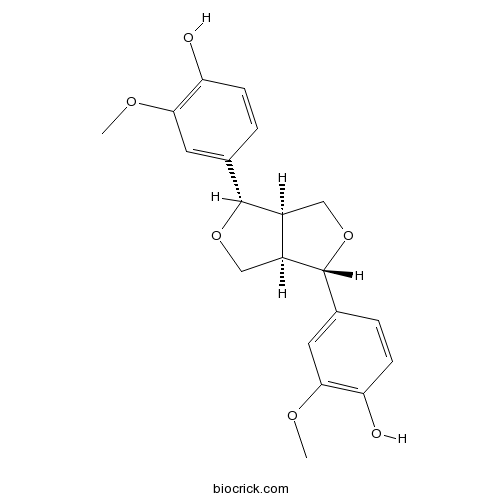An enantiomer of pinoresinol having (+)-1S,3aR,4S,6aR-configuration.
InChI=1S/C20H22O6/c1-23-17-7-11(3-5-15(17)21)19-13-9-26-20(14(13)10-25-19)12-4-6-16(22)18(8-12)24-2/h3-8,13-14,19-22H,9-10H2,1-2H3/t13-,14-,19+,20+/m0/s1
Pinoresinol , among plant lignans, has the strongest antiinflammatory properties by acting on the NF-κB signaling pathway in human intestinal Caco-2 cells.[1]
Pinoresinol-Rich Olives has chemopreventive, anticancer and anti-Inflammatory effects.[2]
Pinoresinol, a lignan of wide distribution in plants, is found to occur as a minor component in the defensive secretion produced by glandular hairs of caterpillars of the cabbage butterfly, Pieris rapae, serves for defense in a caterpillar.[3]
Pinoresinol can ameliorate CCl4-induced acute liver injury, and this protection is likely due to anti-oxidative activity and down-regulation of inflammatory mediators through inhibition of NF-kappaB and activating protein 1 (AP-1).[4]
(+)-Pinoresinol possesses fungicidal activities and therapeutic potential as an antifungal agent for the treatment of fungal infectious diseases in humans.[5]
English website: Pinoresinol
Japanese website: Pinoresinol
Chinese website: Pinoresinol
[1] During A, Debouche C, Raas T, et al. J Nut, 2012, 142(10):1798-805.
[2] Ricciardiello L, Boland C R, Romano M, et al. US 20090048187 A1[P]. 2009.
[3] Schroeder F C, Eisner T. P Natl Acad Sci USA, 2006, 103(42):15497-501.
[4] Kim H Y, Kim J K, Choi J H, et al.J Pharmacol Sci, 2010, 112(1):105-12.
[5] Hwang B, Lee J, Liu Q H, et al. Molecules, 2010, 15(5):3507-16.
[6] Lin B, Shuai N. Chinese Journal of Drug Application & Monitoring,2013(03):147-9.



